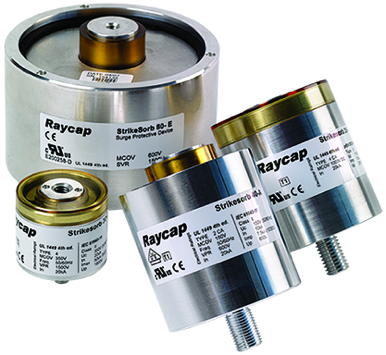Strikesorb is the premier offering from Raycap for surge and lightning protection for wind power systems. Today, more wind farms continue to be built and current wind farms are being expanded and upgraded. As this trend continues, both turbine manufacturers and wind farm owners/operators are becoming increasingly aware of the costs associated with damage to these systems from lightning. The costs that occur when a turbine sustains a lightning strike come in two forms: the monetary costs associated with replacing machinery caused by physical damage and the costs associated with the system being taken offline and becoming incapable of producing power.
Electrical systems inside wind turbines are at risk and face continual challenges based on the fact that they are generally the tallest structures in an often exposed landscape. They are continuously at the mercy of harsh weather conditions, and the likelihood of a turbine being struck by lightning several times throughout its lifespan is very real. The costs of equipment replacement and repair must be factored into the business plan of any wind farm operator. Lightning currents are often passed through the electrical system directly to sensitive electronic equipment within the turbine itself. As the current propagates throughout the system, it produces both immediate and latent damage to circuitry and computerized equipment, including components inside wind turbine generators, transformers, power converters, control electronics, communication, and SCADA systems. Direct and immediate damage may be obvious, but latent damage that occurs as a result of multiple strikes or repeated exposure to surges can occur to key power components within a wind turbine, and many times, this damage will not be covered by the manufacturer’s warranties.
Offline costs are another major factor that must be figured into any business plan associated with a wind farm. These costs come when a turbine is disabled and must be worked on by a service team, or components are replaced, which involves purchase, transport, and installation costs. The revenues that can be lost due to a single lightning event can be significant, and the latent damage that is produced over time adds to that total. Raycap’s Strikesorb products significantly reduce these associated costs because they do not need to be reset or replaced, even after multiple instances of lightning strikes.
Before Strikesorb, the major issue with SPDs designed for wind turbine installations had been their design. For many years, the primary surge protection technology available to wind turbine manufacturers was conventional metal oxide Variables (MOVs) inside plastic housings with DIN rail mountings. While there are places where these types of SPDs are entirely suited, they are typically not the right solution for wind turbine protection. Direct or indirect strikes on wind turbines will produce surge current levels far exceeding the capacities of these devices, and the possibility of multiple strikes and surges in a short time is high. Conventional SPD designs require replacement once a surge has occurred. The downtimes in between operations and restoration time needed by service crews are a major source of revenue loss due to production outages. Raycap’s state-of-the-art product, Strikesorb® requires no maintenance or replacement after a surge. Combined with the fact that it is housed in a more robust cylindrical aluminum housing, this provides lifetime protection to wind turbine systems. Strikesorb’s unique design offers lifetime protection against surges as it resolves aging issues that can seriously impact the performance of most traditional DIN rail-mounted SPD technologies. Strikesorb SPDs can sustain multiple lightning strikes and power surges without requiring maintenance.
Strikesorb is classified as a Class I or Class II SPD according to the international IEC 61643-11 standard for surge protection devices. All versions are fully compliant with the UL1449, 5th Edition Safety Standard.

